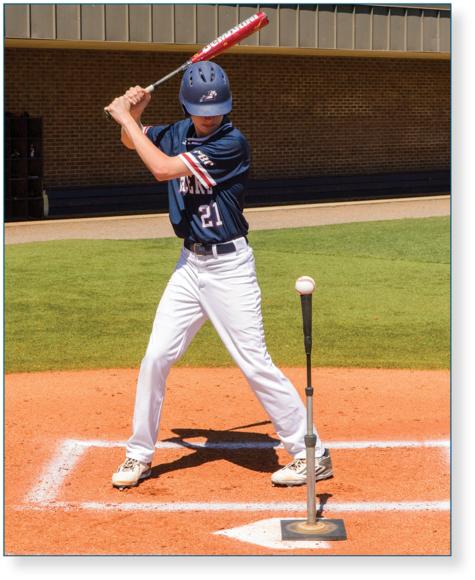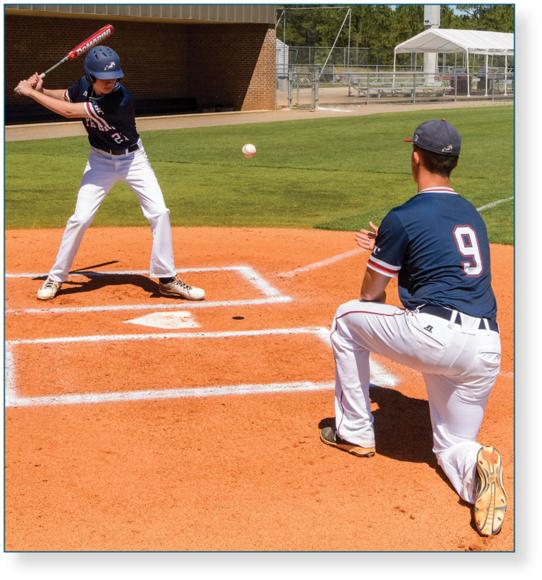Training the Swing
This is an excerpt from Baseball: Steps to Success by Kenny Thomas,DJ King.
The baseball swing is complex, to say the least. The swing is a mental and physical series of actions that must work through the total body in precise harmony. Training these actions can be done in a variety of ways such as tee drills, soft toss, front toss, and batting practice, all of which have multiple variations that cater to specific needs. Our approach for training the swing will remain consistent throughout these drills.
"Squaring up" the baseball, or perfect contact, can be defined as hitting the ball on the same trajectory as it was delivered. You will be hitting on a line straight through the pitcher's release point. With this in mind, the following drills are designed to create a repeatable swing so that you can consistently square up the ball at contact.
Each swing has a result called ball flight. The trajectory of the ball off the bat will help you determine the quality of the swing, giving you immediate feedback regarding flaws in your timing or mechanics. Using the ball flight as a tool, you should be able to make minor adjustments to correct the issue.
Hitting Drill 1: Tee Work
Tee drills eliminate the movement of the baseball. The object is to place the ball at the exact point where you want to make contact. From your batting stance, our first drill will have the ball placed at belt height, even with the front leg, and centered on the plate (figure 5.3). This contact point is the neutral reference for perfect contact, resulting in a line drive through the middle of the field. Take 10 swings, driving the ball through the center of the field.

Tee work drill.
To Increase Difficulty
- The tee drill has many variations. Each variation focuses on certain skill elements that the hitter can single out. These variations are:
- The outside or inside pitch
- High tee or low tee
- Blind swings
- Step through and swing
- Top hand or bottom hand swings with a smaller bat.
To Decrease Difficulty
- Place the tee at a single contact point in the center of the plate.
Success Check
- What was the flight path of the ball after contact? Did it slice away from you? Did it topspin to the ground?
- What did you feel that was different when you squared up the ball versus when the ball had a different flight path?
- Were you able to make adjustments from swing to swing?
- Did your results remain consistent throughout the drill?
Score Your Success
- You earn 1 point for every line drive between the second baseman and the shortstop.
- You earn 1/2 point for a hard-hit ground ball in the same region.
- You earn 0 points for a ball hit above 20 feet (6 m) or outside the given area.
- Your score ____ of 10
Hitting Drill 2: Soft Toss
Soft toss adds the element of timing the body movement and the swing with the ball in flight. With a coach or partner on a knee in the opposite batter's box, have the hitter in the batting stance. The ball should be shown to the hitter. The coach lowers the ball, triggering the load of the hitter. The coach then raises the arm, flipping the ball to a given contact point, thus triggering the hitter to swing (figure 5.4). For this drill, let's take three rounds of eight swings.

Soft toss drill.
To Increase Difficulty
- Have the partner toss the ball from the catcher's box.
- Speed up the pace between flips.
- Challenge the hitter's various contact points (in, out, up, down).
- Use the top hand or bottom hand only with a smaller bat.
To Decrease Difficulty
- Slow down the rhythm of the flip.
- Flip to the same spot every time.
Success Check
- The success checks remain virtually the same as those for the tee drills.
- Because the ball is in flight, your timing and rhythm may be affected.
- Can you still repeat your swing, getting successful results, as you did with the tee drill?
Score Your Success
- You earn 1 point for every line drive between the second baseman and the shortstop.
- You earn 1/2 point for a hard-hit ground ball in the same region.
- You earn 0 points for a ball hit above 20 feet (6 m) or outside the given area.
- Round 1 ____ of 8
- Round 2 ____ of 8
- Round 3 ____ of 8
- Your score ____ of 24
More Excerpts From Baseball: Steps to Success
SHOP

Get the latest insights with regular newsletters, plus periodic product information and special insider offers.
JOIN NOW


